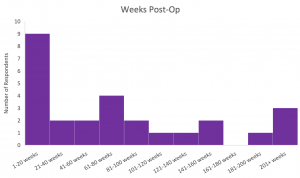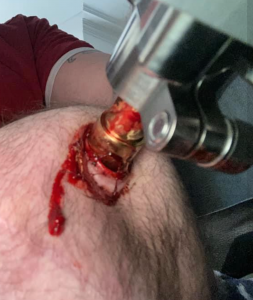Bleeding
Incidence and Timing
Several terms were used when persons described bleeding including bleeding, blood, bled, and bleed. Of these terms, “bleeding” was the most frequently used symptom description, followed by “blood”. The terms “bled” and “bleed” did not yield any additional postings that had not been identified using the first two terms; the term “sanguineous” was not used in any postings.

The length of time since osseointegration surgery was reported in 27 of the responses and ranged from 1 week – 260 weeks, with a median time since OI of 69 weeks. While bleeding was most often reported in the first 20 weeks post-OI, 4 persons reported bleeding later than 200 weeks (almost 4 years) post-OI.

Symptoms
In general, most of the bleeding was described as occuring after large amounts of activity, including walking long distances, working, or strenuous exercise. There were also reports of bleeding occurring after the amputated limb had received a blow as a result of falling or hitting it on something. Those falling or hitting their amputated limb usually described heavy bleeding from the stoma, rather than the oozing or slight discharge that was reported for exercise/walking. Bleeding was also reported after using a lubricant that irritated the stoma. There were also several reports of bleeding due to the sharp edge of the implant cutting into the skin until it bled. It also appeared that some respondents listed regular bleeding as being normal for them, with stoma discharge being frequently tinged with blood. One respondent shared that they would bleed overnight.

What People Have Tried
The actions that people took in response to bleeding were diverse, however some patterns emerged. Common solutions for bleeding were using breast pads or surgical sponges under the stoma to catch the blood (in instances where bleeding was frequent these had to be changed multiple times a day), daily cleaning of the stoma (this ranged from regular body wash or soap in the shower, to using different mixtures of cleaning agents), and decreasing the amount of activity to rest the leg. It was also recommended to change bed sheets often. In the case of the sharp edge of the implant cutting into the skin, one respondent shared that they had the sharp edge ground off so that it was smooth.
Some of the treatments administered to the areas that were bleeding also included application of silver nitrate treatments, oregano oil and colloidal silver mixtures, as well as application of lubricating gel or drops (Viscotears eye drops or KY Jelly). The reported response to bleeding as a result of overuse was most often rest and keeping the stoma clean, while the responses that were about regular bleeding spoke more about using breast pads or surgical sponges to catch the discharge.
Help keep this resource alive.
Visit this Qualtrics link to fill out a survey on bleeding so we can continue to grow the information and keep it up to date.
